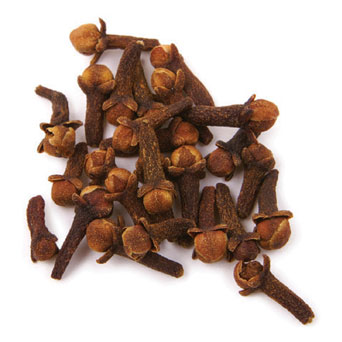Ács K, Balázs VL, Kocsis B, Bencsik T, Böszörményi A, Horváth G BMC Complementary and Alternative Medicine, 2018 ABSTRACT: BACKGROUND: The increasing number of multidrug-resistant bacteria and the fact of antibiotic resistance is leading to a continuous need for discovering alternative treatments against infections, e.g. in the case of respiratory tract diseases. Essential oils (EOs),… Read more »

- Botanical Name: Eugenia caryophyllata
- Alternative Names: Clove bud
- Botanical Family: Myrtaceae
- Primary Constituent: Eugenol
- Other Main Constituents: Caryophyllene, Eugenol acetate
- Distillation Method: Steam Distillation
- Plant Part: Bud
Solid Lipid Nanoparticles (SLN) carrying Eugenia caryophyllata essential oil: The novel nanoparticulate systems with broad-spectrum antimicrobial activity
Fazly Bazzaz BS, Khameneh B, Namazi N, Iranshahi M, Davoodi D, Golmohammadzadeh S Letters in Applied Microbiology, 2018 ABSTRACT: In the present study, solid lipid nanoparticles containing Eugenia caryophyllata essential oil (SLN-EO) were prepared by high-shear homogenization and ultrasound methods, and used to eradicate pathogens. SLN formulations were evaluated for their size, zeta potential and… Read more »
Does the Fragrance of Essential Oils Alleviate the Fatigue Induced by Exercise? A Biochemical Indicator Test in Rats
Li Z, Wu F, Shao H, Zhang Y, Fan A, Li F Evidence-Based Complementary and Alternative Medicine, 2017 OBJECTIVE: To study the effect of the essential oils of Citrus sinensis L., Mentha piperita L., Syzygium aromaticum L., and Rosmarinus officinalis L. on physical exhaustion in rats. METHODS: Forty-eight male Wistar rats were randomly divided into a control group, a fatigue group, an essential oil mixture… Read more »
Essential oils of culinary herbs and spices display agonist and antagonist activities at human aryl hydrocarbon receptor AhR
Bartoňková I, Dvořák Z Food Chemistry & Toxicology ABSTRACT: Essential oils (EOs) of culinary herbs and spices are used to flavor, color and preserve foods and drinks. Dietary intake of EOs is significant, deserving an attention of toxicologists. We examined the effects of 31 EOs of culinary herbs and spices on the transcriptional activity of human… Read more »
Basil, tea tree and clove essential oils as analgesics and anaesthetics in Amphiprion clarkii (Bennett, 1830)
Correia AM, Pedrazzani AS, Mendonça RC, Massucatto A, Ozório RA, Tsuzuki MY Brazilian Journal of Biology, 2017 ABSTRACT: In this study were evaluated the anaesthesia and analgesic effects of clove Eugenia caryophyllata, tea tree Melaleuca alternifolia and basil Ocimum basilicum essential oils (EO) during handling of yellowtail clownfish Amphiprion clarkii. Juveniles (3.70 ± 0.75 cm and 1.03… Read more »
Antifungal and Anti-Biofilm Activity of Essential Oil Active Components against Cryptococcus neoformans and Cryptococcus laurentii
Kumari P, Mishra R, Arora N, Chatrath A, Gangwar R, Roy P, Prasad R Frontiers in Microbiology, 2017 ABSTRACT: Cryptococcosis is an emerging and recalcitrant systemic infection occurring in immunocompromised patients. This invasive fungal infection is difficult to treat due to the ability of Cryptococcus neoformans and Cryptococcus laurentii to form biofilms resistant to standard antifungal treatment…. Read more »
Antimicrobial activities of gaseous essential oils against Listeria monocytogenes on a laboratory medium and radish sprouts
Lee G, Kim Y, Kim H, Beuchat LR, Ryu JH International Journal of Food Microbiology, 2017 ABSTRACT: The aim of this study was to evaluate the antimicrobial activities of gaseous essential oils (EO gases) against Listeria monocytogenes on the surfaces of a laboratory medium and radish sprouts. We determined the minimal inhibitory concentration (MIC) and minimal lethal… Read more »
In vitro evaluation of the amoebicidal activity of rosemary (Rosmarinus officinalis L.) and cloves (Syzygium aromaticum L. Merr. & Perry) essential oils against Acanthamoeba polyphaga trophozoites
Anacarso I, Sabia C, de Niederhäusern S, Iseppi R, Condò C, Bondi M, Messi P Natural Product Research, 2017 ABSTRACT: Several species of the genus Acanthamoeba cause human diseases. Treatment of infections involves various problems, emphasising the need to develop alternative antiprotozoal agents. We studied the anti-amoebic activity of Essential Oils (EOs), derived from rosemary (Rosmarinus officinalis… Read more »
Antibacterial and antibiofilm activities of eugenol from essential oil of Syzygium aromaticum (L.) Merr. & L. M. Perry (clove) leaf against periodontal pathogen Porphyromonas gingivalis
Zhang Y, Wang Y, Zhu X, Cao P, Wei S, Lu Y Microbial Pathogenesis, 2017 ABSTRACT: The antibacterial effect and mechanism of eugenol from Syzygium aromaticum (L.) Merr. & L. M. Perry (clove) leaf essential oil (CLEO) against oral anaerobe Porphyromonas gingivalis were investigated. The results showed that eugenol, with content of 90.84% in CLEO, exhibited antibacterial… Read more »
Antifungal activity of essential oils on two Venturia inaequalis strains with different sensitivities to tebuconazole
Muchembled J, Deweer C, Sahmer K, Halama P Environmental Science and Pollution Research, 2017 ABSTRACT: The antifungal activity of seven essential oils (eucalyptus, clove, mint, oregano, savory, tea tree, and thyme) was studied on Venturia inaequalis, the fungus responsible for apple scab. The composition of the essential oils was checked by gas chromatography-mass spectrometry. Each essential oil had its main compound…. Read more »
